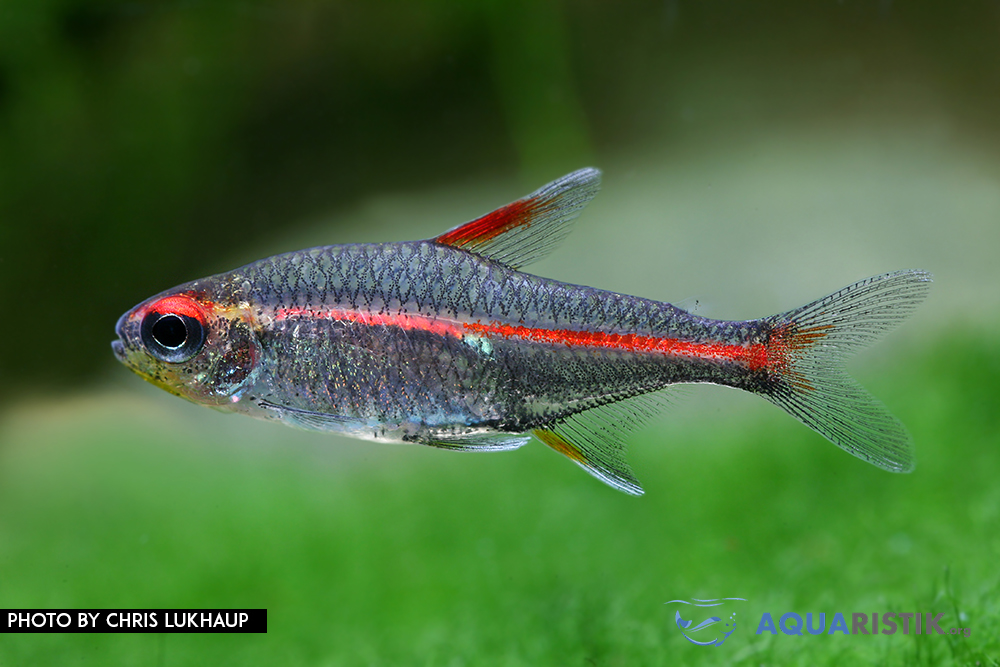In our series of tetras (such as the black neon) we want to introduce another species today, which is a real eye-catcher. It is about the Glowlight Tetra Hemigrammus erythrozonus. We have one here too Characteristics prepared and deliver the most important things there attitude, breeding, care and appearance of the glow-light tetra Hemigrammus erythrozonus. Above all, the beautiful colors have to be mentioned positively. He also makes a special picture in the home aquarium, especially if you can keep and care for a larger swarm.

Origin and distribution of the glow-light tetra
This species of tetra also got its name from its special appearance, because the coloring suggests that this is where the name comes from. As early as 1933, the fish became native to us and moved into the aquariums. This tetra species also originally comes from South America and of course still today. There especially in the Guiana area and in the catchment area of the Essequibo. As already with Red-headed Tetra This ornamental fish also comes from the black water and lives there mostly in shady forest streams. This says a lot about how to care for the fish in the aquarium. Schwarzwasser has very special requirements and there are also a few things to consider when it comes to lighting. Since breeding is really easy here, you will increasingly be able to buy this fish as offspring from us. Wild caught should be rather rare.
Appearance and characteristics of the glow-light tetras
If you look at the fish in the picture above, then it certainly doesn't need many words to describe the appearance. The body of the animals is grey-brown and/or olive green and the main distinguishing feature is certainly the distinctive stripe which extends from the gill cover to the caudal fin. This is ruby red and therefore particularly beautiful to look at. If you dim the light in the aquarium a little, you will find that the colors are shown to their best advantage. In addition, this strip then seems to get a different color.
It also seems to be the case here that this luminous strip had an influence on the German naming. You could already see a "glow". In addition to the stripes, there is another feature, because the ornamental fish is also red above the eye. It also has red markings on its dorsal fin and tail fin. The anal fin usually has a rather golden stripe. The body shape is very similar to that of the neons and is rather elongated.
Of course, there are also certain differences between males and females. Females are larger than males at around 4,5 cm in length. They only grow to 3,5 cm.
The animals are about 6 years old.
Keeping and caring for glow-light tetras
Let's get to the attitude in our home aquariums. First of all, it has to be said that the glow-light tetra must definitely be kept in a group. Groups of 10 or more animals are best. The bigger the group the better. Of course, the aquarium size must also match. We do not recommend keeping the animals below 100 liters. Above all, you should also be aware that disputes can arise in larger groups. Here the males are usually rough on each other and sometimes they bite their fins. Usually only if there is not enough space.
When it comes to temperature, there are only a few requirements. Here you are very well served with the middle 25 degrees. Anything between 24 and 28 degrees should be fine. The glow-light tetras are also very tolerant of the Ph value and values of up to 7,5 are possible. The water doesn't have to be particularly soft either. A total hardness of 12 degrees is still acceptable.
Here, too, the aquarium should be set up rather dark, because these fish are ornamental fish from a blackwater area. Therefore, the background should be kept rather dark. In addition, the lighting should not be too bright.
When it comes to socializing, the glow-light tetra makes few demands because it is quite peaceful and can be socialized with other tetras without any problems.
Let's recap.
Characteristics of the glow-light tetra
- Temperature between 24 – 28
- Degree Ph value from 6 – 7,5
- GH up to 12 degrees
- From 10 animals
- school fish
- Good planting
- Aquariums from 100 liters
Breeding and reproduction of glow-light tetras
Here the glow-light tetra differs only slightly from the other tetras. He is also a free spawner and lays hands on his own eggs, so that he must also be removed from the breeding tank immediately after the spawning process.
The water should be slightly acidic and rather softer than the normal environment. In addition, the aquarium should be well planted. Floating plants and fine-grained plants have proven themselves. A slight darkening has also proven its worth in practice.
The eggs will attach to plants or fall to the ground so it is advisable to use a spawning strainer. This means that the parent animals can no longer get to the eggs and larvae and it is not so bad if you forget the time of removal.
Once the larvae have hatched, it takes about 5 days for the young to swim freely. Before that, they feed on their yolk sac. If this is used up, then the animals must be fed with microorganisms. Also serve this purpose Artemia naupien and micro crabs.





